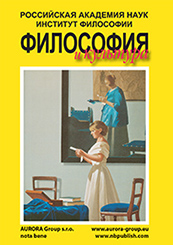Philosophy and art
Reference:
Grigoreva, A. (2024). Defining the boundaries of the meaning of ornamental compositions in the art of the Pazyryk culture. Philosophy and Culture, 10, 1Ц12. https://doi.org/10.7256/2454-0757.2024.10.71893
Abstract:
The article is devoted to the analysis of the semiotic field of the term "ornamental composition" in the context of definitions of ornament and composition in the art of the Pazyryk culture and its historiography. The subject of the study is ornamental compositions from elite burials of the Pazyryk culture of different periods of its development Ц the early Second Bashadar kurgan and the Tuekta burial ground and the late Pazyryk burial ground. In addition, the paper examines the specifics of the use of the terms "composition" and "ornament" in order to highlight the history of their meanings, as well as analyzes certain provisions of theoretical works on the study of the theory of composition and ornament. The purpose of the study is to identify the components of the semantic field of an ornamental composition related to the field of interaction of the composition with the viewer, and not to the field of meaning of specific figurative images.†The article proposes using the method of formal analysis in combination with some provisions of the Gestalt approach described in the works of E. Gombrich and R. Arnheim to analyze a series of ornamental compositions with and without figurative images in the art of the Pazyryk culture. The scientific novelty of the study is predetermined by the absence in the Russian historiography of works describing the specifics of the meaning of ornamental composition in the context of visual perception in the art of the Pazyryk culture. The researchers note that the significance of ornaments in Pazyryk art could be related to the meaning of multi-figure compositions (when zoomorphic images are included in the ornament) and reflect the worldview of the bearers of the Pazyryk culture, or the types of symmetry used in the construction of ornaments could reflect the social structure of society. However, in both of these trends, the analysis of an ornamental composition without figurative images remains outside the scope as a structural and semantic, integral work of art interacting with the viewer. As a result of the research, the assumption is put forward that it is possible to designate a single semantic field for ornamental and multi-figure compositions in Pazyryk art. Clarifying and expanding the scope of the ornamental composition allows us to identify a single specificity of interaction with the viewer of both figurative and non-figurative images of Pazyryk art, to emphasize the game element in the nature of culture.
Keywords:
the meaning of the ornament, terminology issues, composition, Altai, Pazyryk culture, animal style, the ornament, visual perception analysis, burials, The Scythian-Siberian world
Philosophy and culture
Reference:
Wang, G. (2024). The dialogue of the past and the present in the innovative trends of the works of pottery of Qinzhou Nixing. Philosophy and Culture, 10, 13Ц29. https://doi.org/10.7256/2454-0757.2024.10.71926
Read the article
First Peer Review:
Second Peer Review:
Third Peer Review:
|
EDN: WLCXDH

|
Abstract:
The object of this study is the ceramic art of Qingzhou Nisin, which has a history of over 1300 years. The aesthetic characteristics of Qingzhou Nisin ceramics are highlighted, and the current situation of insufficient innovation in modern ceramics is summarized and analyzed. The importance of design innovations is emphasized. A new method of innovative design for Qingzhou Nisin ceramics is proposed, which involves combining the regional culture of Guangxi Beibu Gulf with traditional artistic elements of Qingzhou Nisin ceramics to give them new vitality. The article highlights four aspects that facilitate the realization of innovations in Qingzhou Nisin ceramic design: the fusion of pattern elements, the integration of morphological elements, the integration of texture components, and the use of complex materials. The research methodology includes a literature review of Qingzhou Nisin ceramic art and its contribution to the development of innovative trends in this direction, an analysis of Qingzhou Nisin's works was made in order to understand its style and approach to creating ceramic art. The main conclusions of the study are that Qingzhou Nisin ceramic art is an important part of Chinese civilization, and its development should be based on preserving the continuity of traditions and culture. To restore the connection between the regional culture of Guangxi Beibu Gulf and innovations in Qingzhou Nisin ceramic design, research and innovation practices are necessary. To develop Qingzhou Nisin ceramic art, innovations in design should be based on preserving the continuity of traditions and culture, as well as restoring the connection between regional culture and innovations. Overall, the article shows that Qingzhou Nisin ceramic art is an important part of Chinese civilization, and its development should be based on preserving the continuity of traditions and culture.
Keywords:
pottery craft, Chinese ceramics, Qinzhou Nixing, Nixing ceramics, regional culture, design innovations, intangible cultural heritage, ceramics, pottery industry, pottery art
Methodology of philosophical learning
Reference:
Skorokhodova, T.G. (2024). The Poet-Creator of Philosophy: To the Methodology of Research in Philosophical Thought by Rabindranath Tagore. Philosophy and Culture, 10, 30Ц42. https://doi.org/10.7256/2454-0757.2024.10.71941
Abstract:
The Indian poet and educator Rabindranath Tagore was the creator of an original philosophy that gives additional meaning to the picture of the history of Indian philosophy in the 20th century. He usually emphasized his identity as a poet and an artist, not considering himself a philosopher. However, Tagore embodies the phenomenon of a poet-thinker who comprehends universal philosophical problems and, in the process of philosophizing, offers his own vision of them. Moreover, he owns a number of texts of a religious-philosophical and socio-philosophical nature, in addition to the content of poetry and fiction. The philosophy created by the poet requires a comprehensive holistic study, which, in turn, raises the problem of research methodology. The article proposes the author's methodology for the reconstruction of Rabindranath Tagore's philosophy, based on an understanding of his personality, the contexts of thought and the hermeneutics of texts.†The methodological model of philosophy reconstruction includes three levels. The first involves analyzing the personality of R. Tagore using the categories "cross-cultural thinker" and "problematic thinker". The second is a description of the contexts of his philosophizing: external general civilizational, internal epochal and internal biographical. The third is the hermeneutics of texts, taking into account the poetic component and the philosophical problems of speeches and fiction. The novelty of the described methodological model is due to the possibilities and prospects of reconstructing Tagore's philosophical thought and concepts. 1. Description of the phenomenon of a poet and writer creating a philosophy in which the experience of artistic creation generates a universal religious and social meaning and actualizes humanistic issues. 2. Presentation of the process of formation of cross-cultural philosophy of the XX century on the material of a particular thinker. 3. The analysis of the contexts of the unfolding of philosophy helps to trace the continuity of the thinker and his ideas with the Indian philosophical tradition in a broad sense and at the same time identify innovation, not least due to his dialogue with Western culture and modernity. 4. Seeing Tagore's philosophy as a kind of quintessence of the Bengali Renaissance heritage, it is not difficult to notice its significance and relevance for modernity. 5. Reconstruction along the proposed methodological path will open up not only direct, but also comparative prospects for studying Tagore's philosophical thought in comparison with the reflections of philosophers from different cultural areas, primarily peripheral to the West and non-Western ones.
Keywords:
religious philosophy, model of reconstruction, context, hermeneutic key, philosophizing, Rabindranath Tagore, Modern Indian Philosophy, the Bengal Renaissance, Methodology of History of philosophy, social philosophy
Philosophy and culture
Reference:
Belyaeva, T.O. (2024). Traditional sacred meanings in the ethnoregional culture of Altai. Philosophy and Culture, 10, 43Ц50. https://doi.org/10.7256/2454-0757.2024.10.70178
Abstract:
This article presents the study of methodological approaches to the study of the traditional sacred ethnoregional culture of Altai. The essence of the concept of "sacred" culture is considered. The theoretical aspects of the study of the "sacred" ethnoregional culture of Altai are revealed. A comparative analysis of various traditional forms of sacredness in the development of the ethnoregional culture of Altai is carried out. The problem of preserving the cultural heritage of Altai is considered.The purpose of the study is to reveal the features of traditional sacred meanings in the ethnoregional culture of Altai. Objectives: - to consider the theoretical aspects of the study of the sacred ethnoregional culture of Altai; - to conduct a comparative analysis of various traditional forms of sacredness in the development of the ethnoregional culture of Altai. The subject of the study is the traditional sacred meanings in the ethnoregional culture of Altai.The object of the study is the ethnoregional culture of Altai. The practical significance of this work lies in the possibility of using the data obtained in the creation of local regional programs for the preservation of ethnocultural traditionalism. †The method and methodology of the work: the basis of the research is the principle of a systematic approach. To study methodological approaches to research, the sources of information were textbooks and monographs by such authors as M. Eliade, T.V. Bernyukevich, I.Ya. Murzina, N.I. Kaplan, G.M. Kazakova, V.A. Lipinskaya and others. Based on this study, it can be concluded that the culture of Altai is a huge layer of ethnographically diverse ethnic groups. Each ethnic group has its own sacred values and social patterns through which these values can be passed on to subsequent generations. This can be traced by the example of the Altai house painting, in everyday objects there is a complex semantic complex of sacralization. On the one hand, painting appears as a way of sacralizing human existence, on the other hand, it is a channel for transmitting appropriate social patterns that influence the consolidation of bearers of a particular culture. The boundaries of the sacred here are determined by the substantial meanings of human existence and the civilizational level of development of the sacralization of values. Traditional sacred meanings are intertwined with the way of life, culture and way of life of the people.
Keywords:
spirituality, Altai, culture, ethnoregional, ethnos, meanings, sacred, traditions, values, directions
Philosophy of technology
Reference:
Pluzhnikova, N.N., Saenko, N.R. (2024). Technology: metaphors of "machine" and "mechanism" in the history of philosophical thought. Philosophy and Culture, 10, 51Ц60. https://doi.org/10.7256/2454-0757.2024.10.72077
Abstract:
The article is devoted to the study of the concept of "technology" in the history of philosophical thought. The authors have consistently analyzed the psychological, symbolic and socio-cultural factors of influence on the processes of the origin and evolution of technology, which is represented in the history, primarily of classical philosophy, in the form of metaphors of "machine" and "mechanism". This research focus makes it possible to study the interaction of human and technical in a historically and culturally mediated philosophical discourse. In conclusion, a brief overview of the models of representation of technology and the image of a person associated with it as a machine or mechanism dominating in modern information culture is given, epistemological philosophical and natural scientific factors of the functioning of this process are highlighted, and a conclusion is made about the dominant concept of technology as a "supporting structure" of modern culture Using the comparative method, ancient, medieval, and modern concepts of technology, as well as the binary opposition of "manЦmachine" formed by it, are studied. For the first time, the reconstruction of the concept of technology was carried out through the analysis of socio-cultural discourse in philosophical constructions. The role of these constructions in culture is determined. The authors came to the following conclusions: 1. The genesis of the concept of technology was associated with the understanding of technology as technology, but technology in ancient thought was a broader concept, denoting the totality of artificial human activity represented in technology (specific objects, images) as a means of defining reality. 2. The "supporting structure" of the concept of technology in Western European culture are the metaphors of "machine" and "mechanism", which laid the foundations for understanding man in a post-industrial society. 3. Modern culture can be considered as a technical and technological reality that continues the reconstruction of the metaphor of the "machine" that has developed in the history of philosophical thought.
Keywords:
schematization, culture, human, society, history of philosophy, mechanism, machine, technology, technic, formalization
 This work is licensed under a Creative Commons Attribution-NonCommercial 4.0 International License.
This work is licensed under a Creative Commons Attribution-NonCommercial 4.0 International License.
 Eng
Eng












 © 1998 Ц 2025 Nota Bene. Publishing Technologies. NB-Media Ltd.
© 1998 Ц 2025 Nota Bene. Publishing Technologies. NB-Media Ltd.




